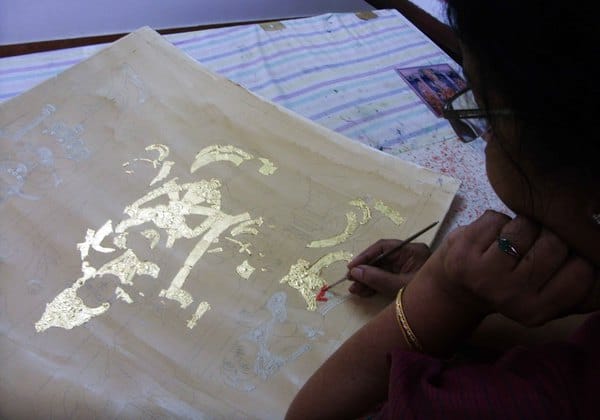Patience and persistence are the words that best describe Prabha Mallesh, who spent almost half of her life – painting. Prabha, 68, has achieved an expertise in ‘Mysore style’ traditional painting and received many awards including the National Award in 1999. She lives in HSR Layout and has held exhibitions of her art around the world, and still continues her journey with traditional painting.

Pic: Anisha Nair
Excerpts from Interview
How did you come across traditional mysore style painting and develop your interests in that?
We do poojas, believe in God and that influenced me. Earlier I was into portrait and landscape painting. Then after sometime, when I saw a lot of idols and the traditional paintings from Mysore, I wanted to work on that. I learnt the art of traditional painting from my guru, Subramanian Raju for seven to eight years and then started doing it by myself. Now I create my own versions of paintings.
You have been painting for over 35 years now. What keeps you going?
Interest is what keeps me going. Because of long hours that I end up sitting to complete one painting, I now have spondylitis. Doctor has advised me not to sit for long and paint. But my interest in this does not let me set it aside.
I used to teach over hundred children. But now, because of my back problem, I have stopped it. I have also been advised not to take orders for the painting but it is difficult for me to stop as I am very much into it. I take my time since the buyers give me a lot of time to prepare a painting.

Prabha Mallesh with her current painting project. Pic: Anisha Nair
Your work is exhibited in many parts of the country and even abroad. How has your family supported you?
My husband has supported me the most. Otherwise where do ladies get to do much and accomplish their interests after marriage? It was my husband who went ahead and supported me with time and I came up to this level only because of him. My children have also been very supportive throughout.
Mysore style traditional painting, mostly depicting depicting various mythological stories, Gods and Goddesses.
This style has a unique method of painting. First, the drawing paper is pasted on a plywood. A paste ‘jesso’ is prepared using ingredients like lead powder and gambose. This paste is applied to emboss and highlight ornaments, structures and other parts wherever required. Then the 22 carat gold leaf is pasted on the embossed areas with a special glue. Further, the design and other intricate colour work is done with poster colours.
This requires a lot of time and patience to complete it. Hence this painting is very rare and expensive.
What is the key point to keep in mind for ‘Mysore-style’ painting?
The key point here is patience. You should have the patience to complete the painting and also have some basic knowledge about the (style of) painting. This is traditional style painting and so you should know some ancient stories and mythological tales. You should be able to ‘create’ work. It is based on the mythological characters so you should have an idea of that as well.
What do the youth in Bangalore think of this style of painting?
There is a demand in this kind of traditional painting now, both in terms of buying and learning. When I used to teach, a lot of students were eager to learn this.
Some of them wanted to make it for their own house, some of them are doing it professionally. But the youth certainly are willing to learn this form of art.
Do you think painting can be used to change the mindsets of the people in any way?
Well, through these paintings, people can be stay rooted to their culture. Though they move forward and adapt western culture, they will have the knowledge about their own culture, Gods and mythology. A lot of NRIs order them.

Sticking the gold leaf on the embossed part. Pic: Anisha Nair
Why are these paintings so expensive?
These paintings take a lot of time to get completed. An average size painting takes about seven to eight months to get completed. Plus, there are 22 carat gold chips used in these paintings, which increases their cost. So the materials used and the effort together, makes these paintings quite expensive.⊕